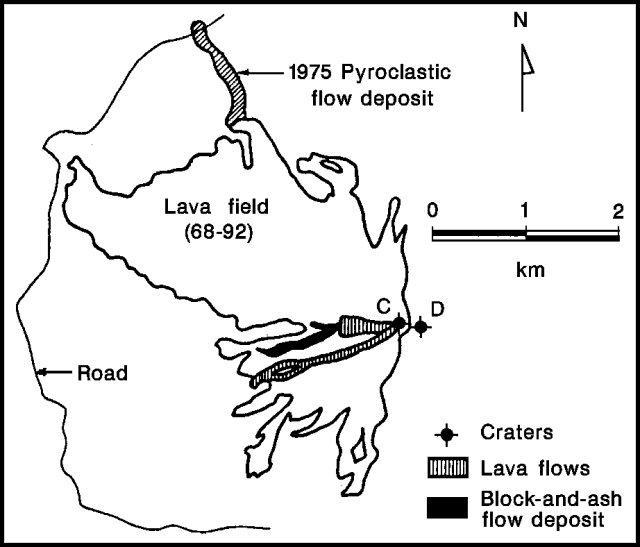Report on Arenal (Costa Rica) — February 1992
Bulletin of the Global Volcanism Network, vol. 17, no. 2 (February 1992)
Managing Editor: Lindsay McClelland.
Arenal (Costa Rica) Strombolian explosions and extrusion of block lava flows
Please cite this report as:
Global Volcanism Program, 1992. Report on Arenal (Costa Rica) (McClelland, L., ed.). Bulletin of the Global Volcanism Network, 17:2. Smithsonian Institution. https://doi.org/10.5479/si.GVP.BGVN199202-345033
Arenal
Costa Rica
10.463°N, 84.703°W; summit elev. 1670 m
All times are local (unless otherwise noted)
Two blocky lava flows continued to extend down the WSW and W flanks in February (figure 44). The WSW-flank flow, which began in mid-to late November, followed the well-defined levees of the September flow. By the end of February, the active flow had surpassed the older flow's front, advancing several meters daily, burning grass, and reaching 1.8 km length (750 m elevation). The 200-m-wide W-flank lava flow extended ~700 m, to 1,200 m elevation, by the end of February. Gravitational collapse of the W-flank's lava flow front on 24 February produced block-and-ash flows that traveled down valleys to 780 m elevation. Geologists believed that an apparent new amphitheater on the WSW side of crater C had caused lava flows to travel preferentially in that direction during recent months.
 |
Figure 44. Map of late 1991-February 1992 lava flows and the 24 February block-and-ash flow at Arenal. Courtesy of ICE. |
Strombolian explosions were low in number and magnitude in February, with 173 recorded during the first 18 days. Many ash emissions, to 1 km height, were observed without obvious explosions. Size analysis of one tephra sample collected on 26 February showed that 85% was coarse-ash and <15% was very coarse ash to fine lapilli. The sample was composed primarily of vesiculated rock fragments, aphanitic and porphyritic in character, and plagioclase crystals.
An average of 10 volcanic earthquakes (a range of 2-24) was recorded daily (at ICE station "Fortuna" 4 km E of the crater) in February. Large increases in tremor period and energy were measured on 6, 7, and 21-25 February, coinciding with increased lava output and strong gas emission. Tremor was recorded up to 24 hours/day.
Geological Summary. Conical Volcán Arenal is the youngest stratovolcano in Costa Rica and one of its most active. The 1670-m-high andesitic volcano towers above the eastern shores of Lake Arenal, which has been enlarged by a hydroelectric project. Arenal lies along a volcanic chain that has migrated to the NW from the late-Pleistocene Los Perdidos lava domes through the Pleistocene-to-Holocene Chato volcano, which contains a 500-m-wide, lake-filled summit crater. The earliest known eruptions of Arenal took place about 7000 years ago, and it was active concurrently with Cerro Chato until the activity of Chato ended about 3500 years ago. Growth of Arenal has been characterized by periodic major explosive eruptions at several-hundred-year intervals and periods of lava effusion that armor the cone. An eruptive period that began with a major explosive eruption in 1968 ended in December 2010; continuous explosive activity accompanied by slow lava effusion and the occasional emission of pyroclastic flows characterized the eruption from vents at the summit and on the upper western flank.
Information Contacts: E. Fernández, J. Barquero, V. Barboza, and R. Van der Laat, OVSCIORI; G. Soto and R. Barquero, ICE.

